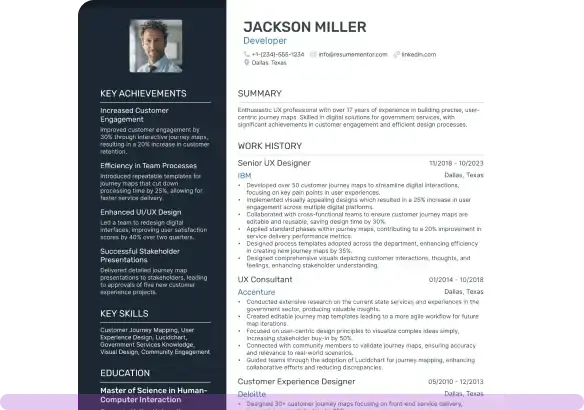User Experience Researcher Resume Examples

Mar 26, 2025
|
12 min read
Uncover the essentials of crafting a user experience researcher resume that captures attention. Dig deep into strategies for showcasing your skills, experience, and value with well-researched words. Make your career leap more than just UX-traordinary.
Rated by 348 people
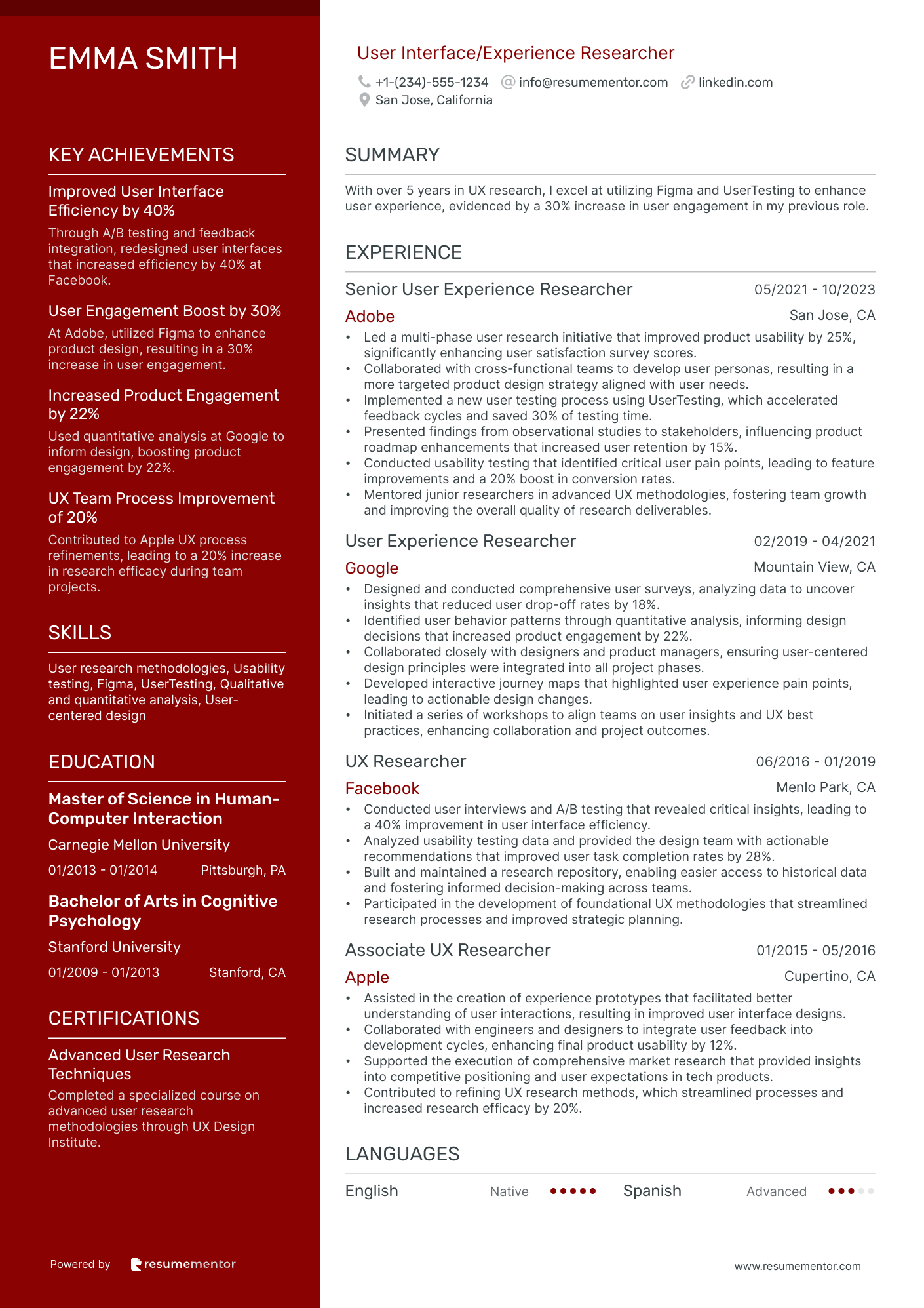
User Interface/Experience Researcher
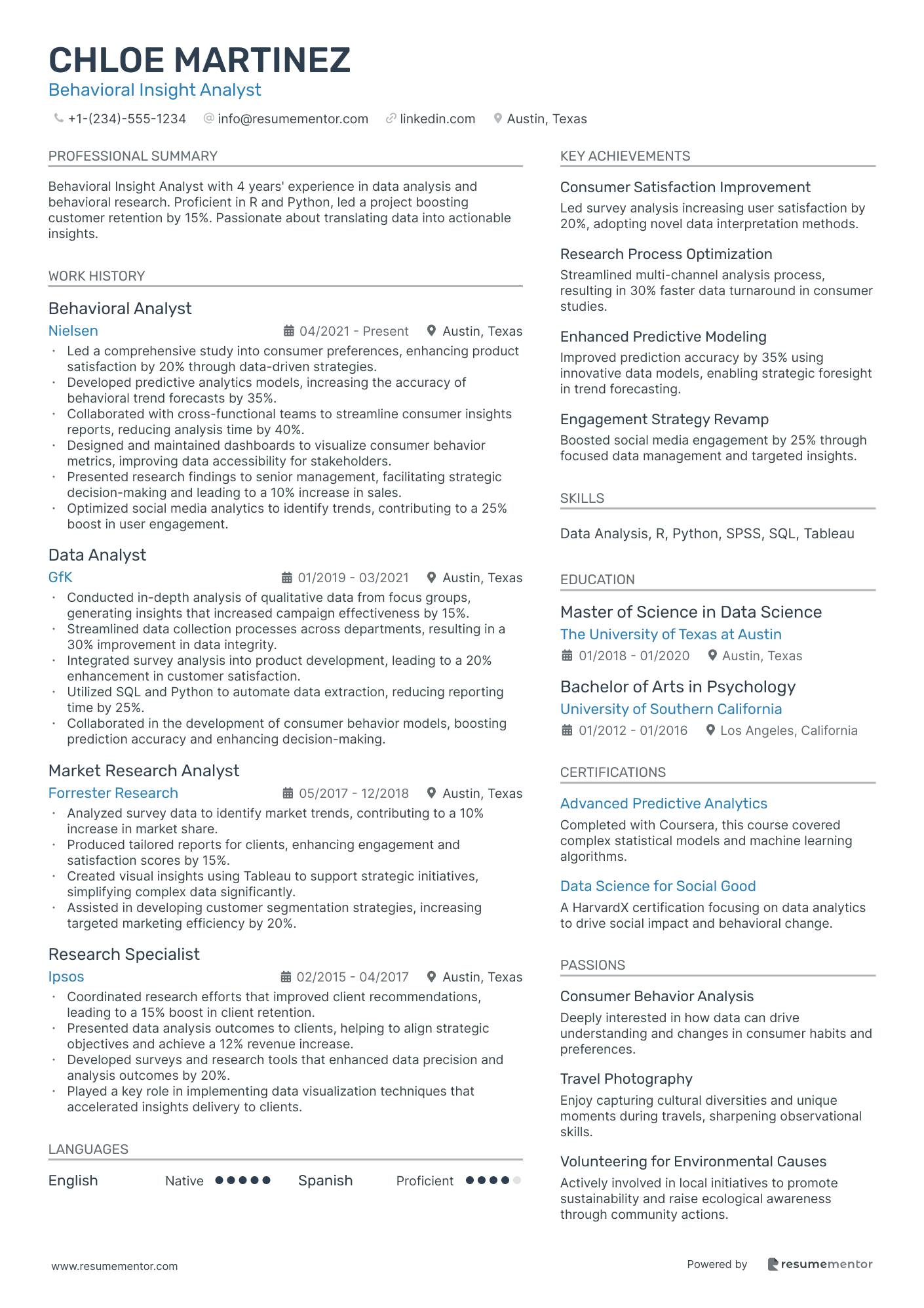
Behavioral Insight Analyst

Interactive User Experience Researcher

Quantitative User Researcher
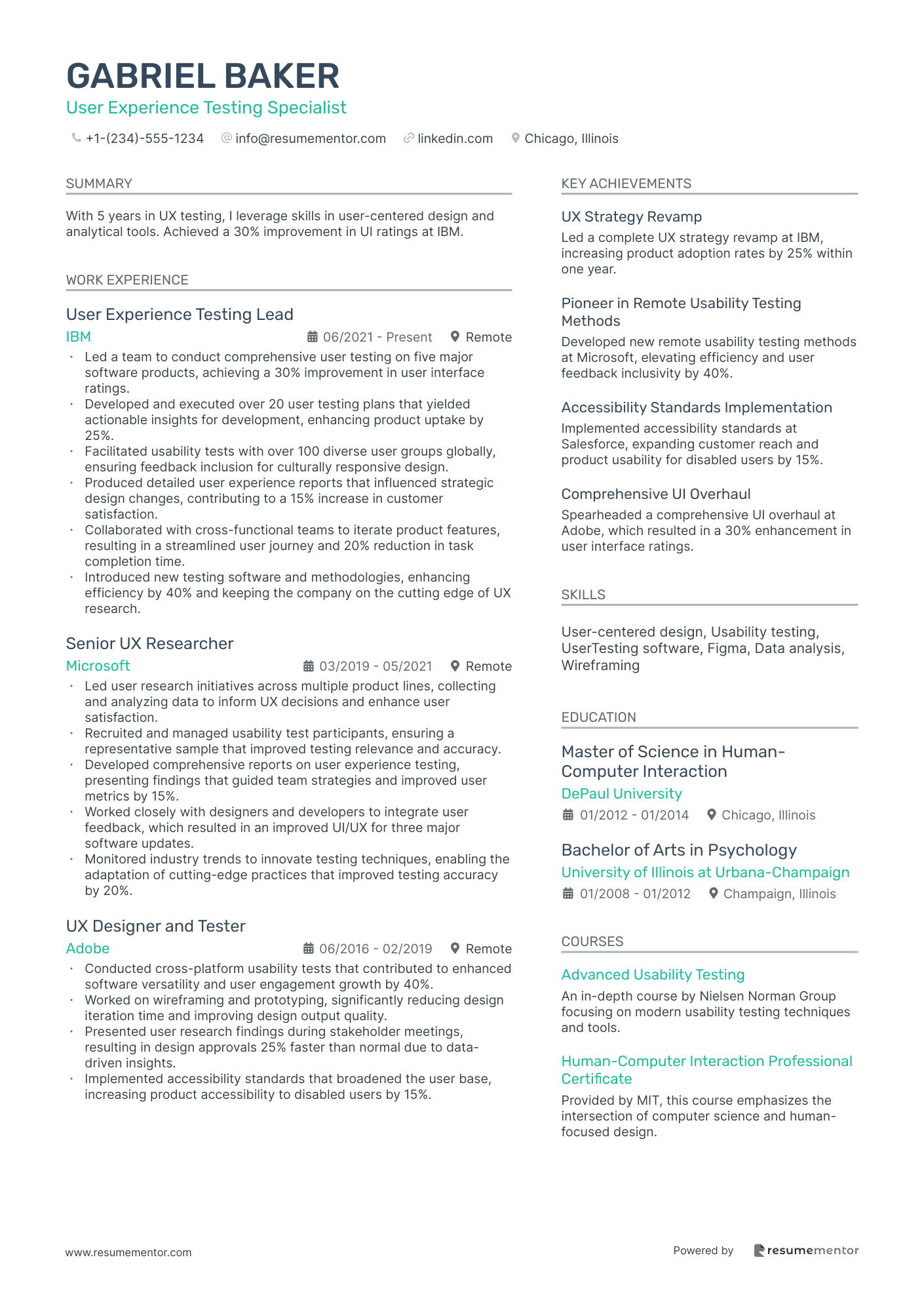
User Experience Testing Specialist
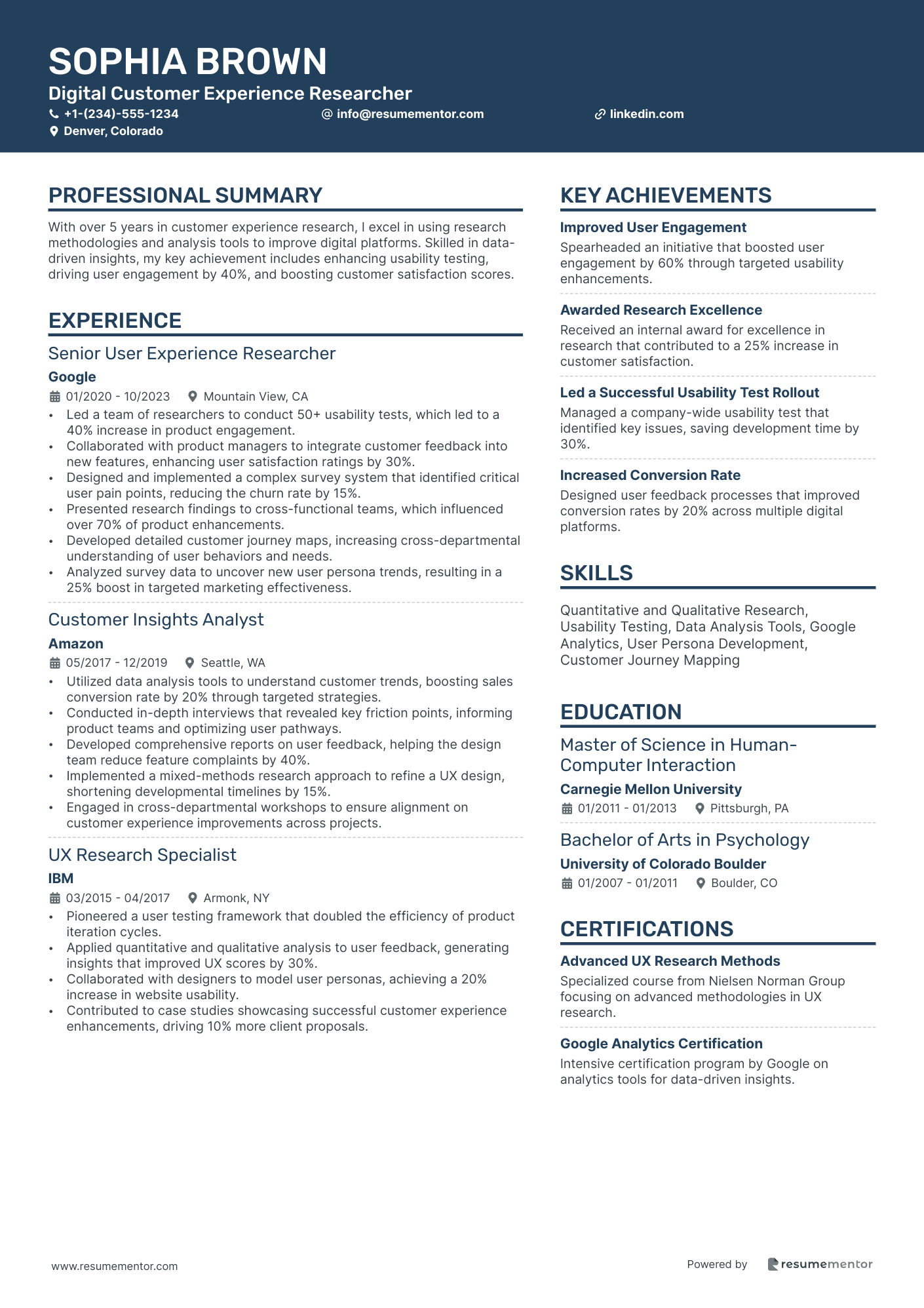
Digital Customer Experience Researcher
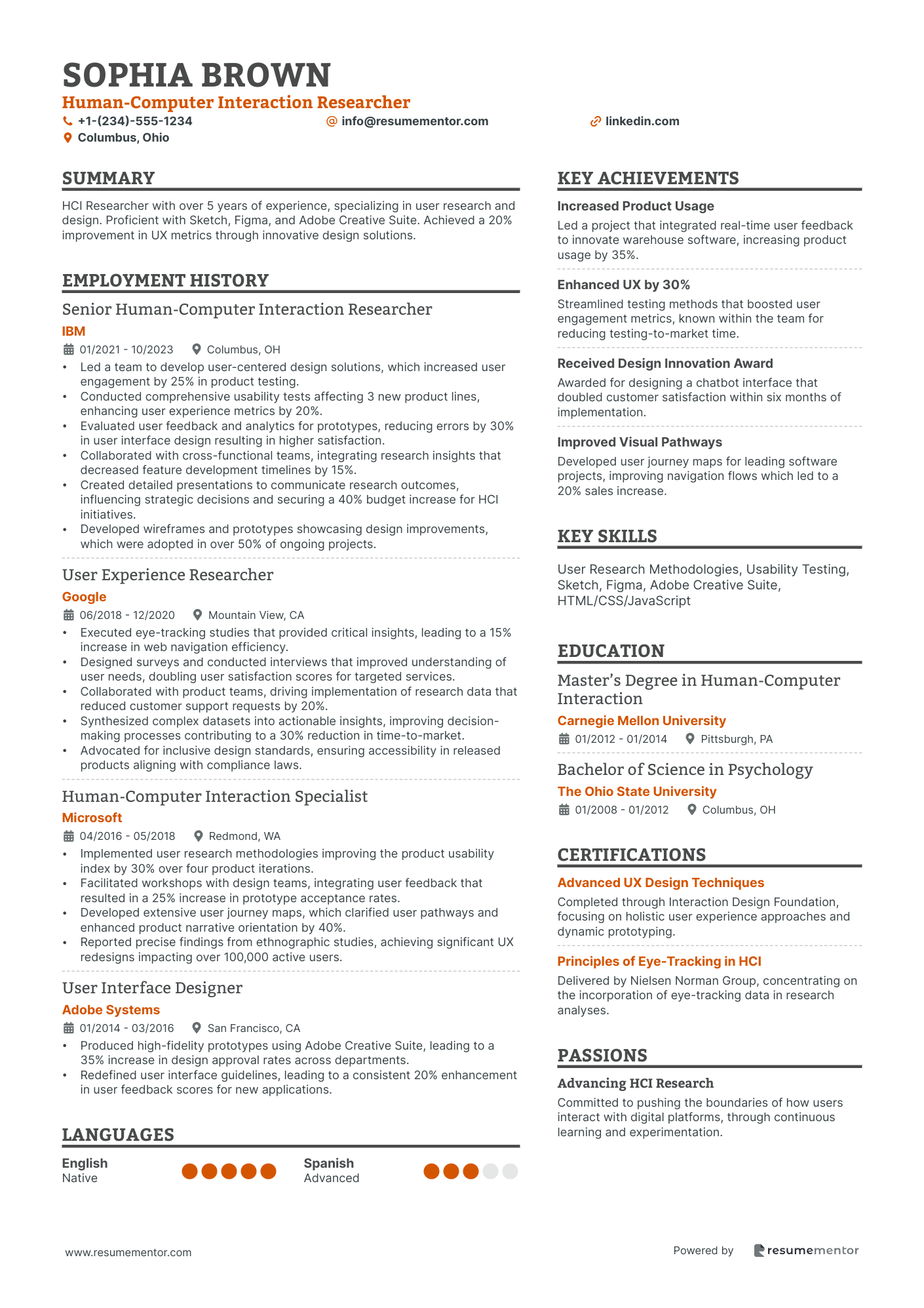
Human-Computer Interaction Researcher
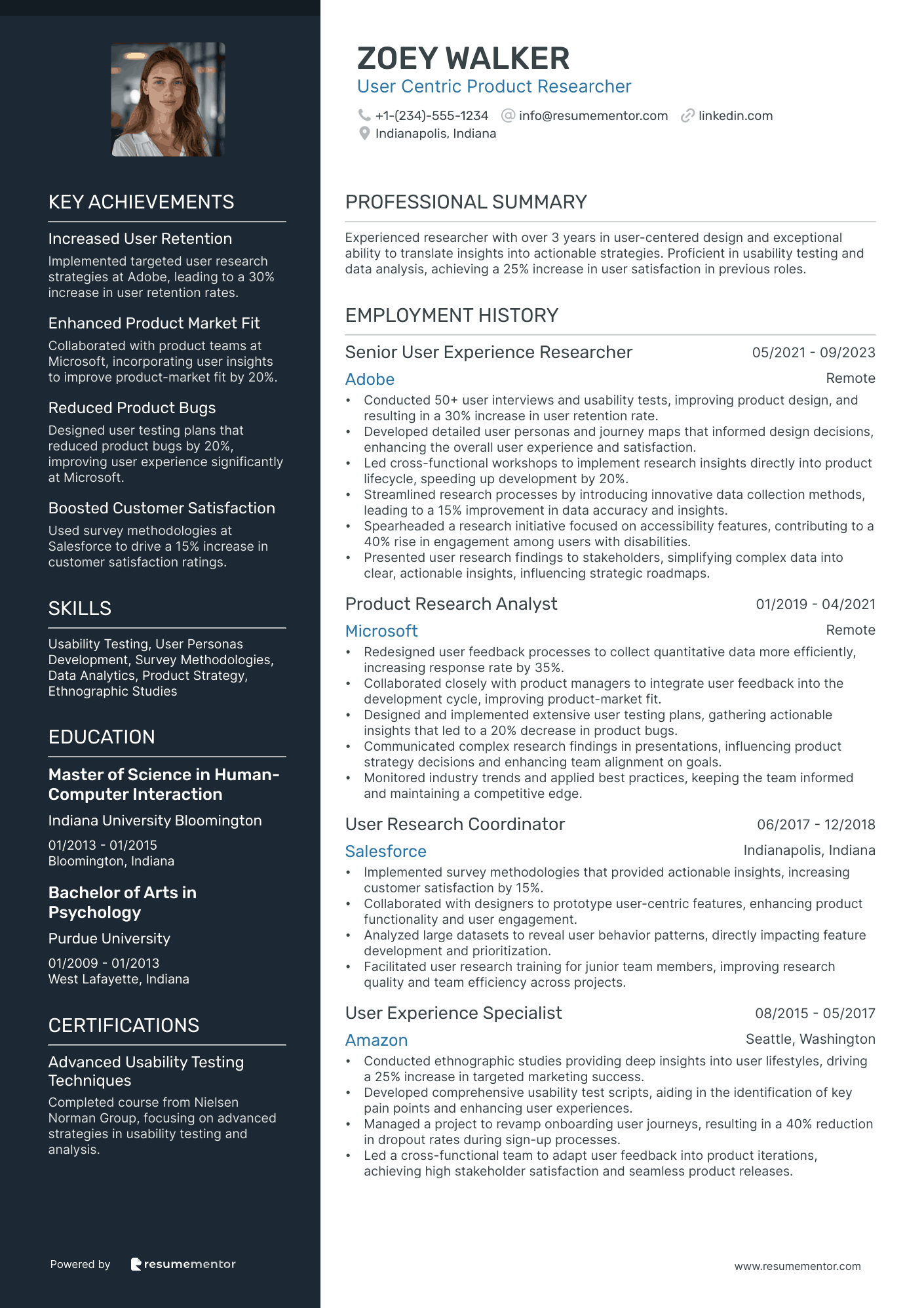
User Centric Product Researcher
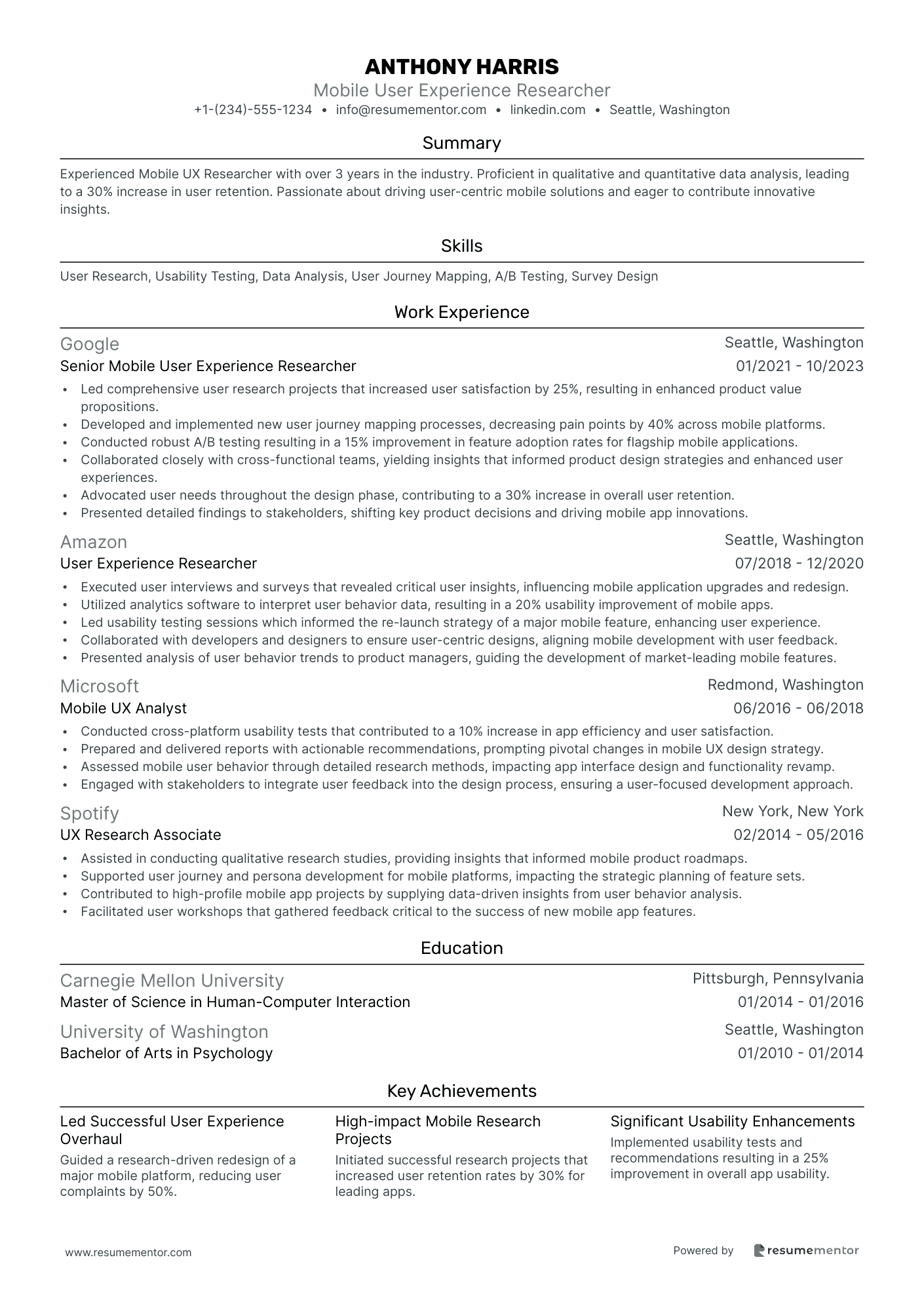
Mobile User Experience Researcher
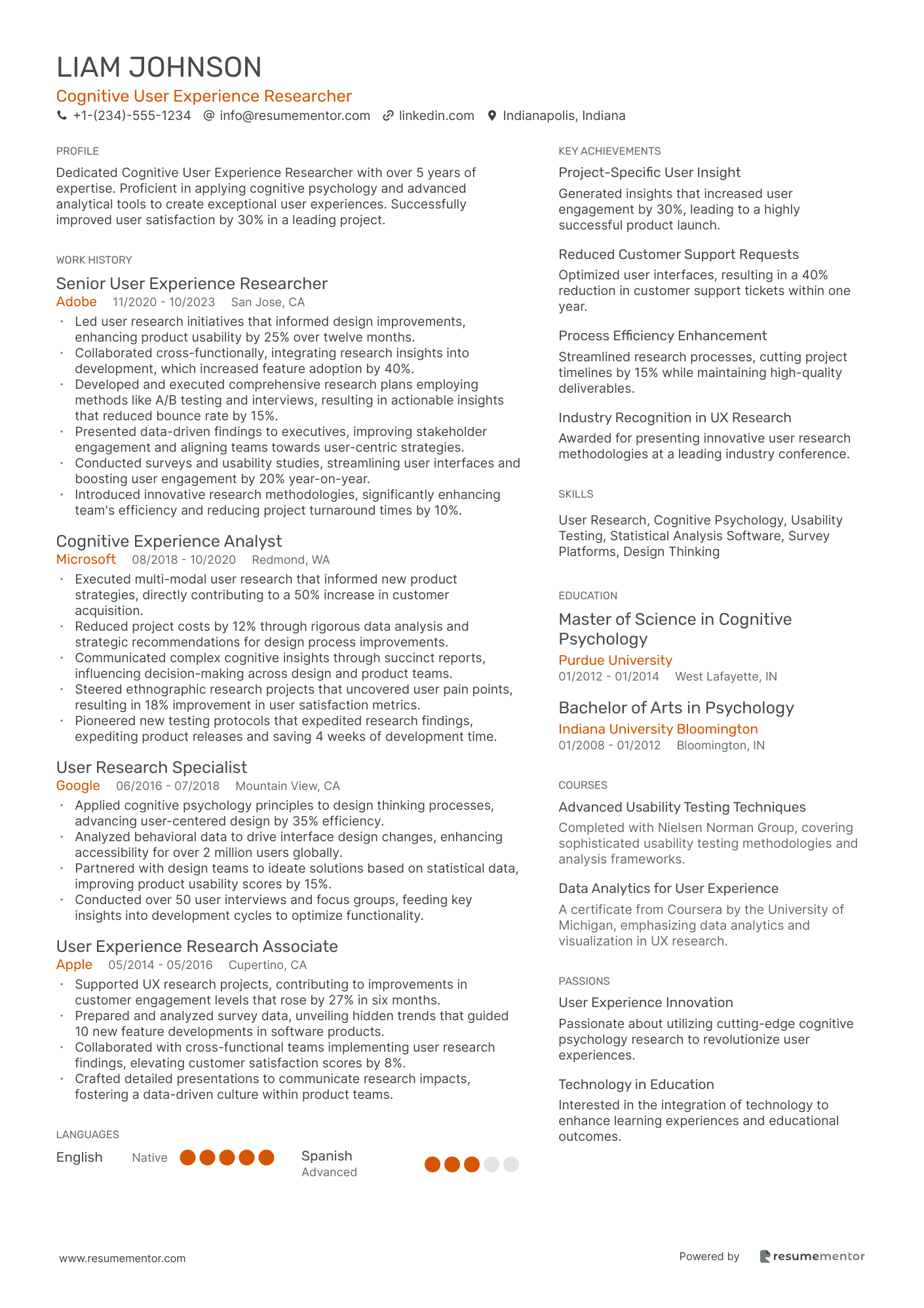
Cognitive User Experience Researcher
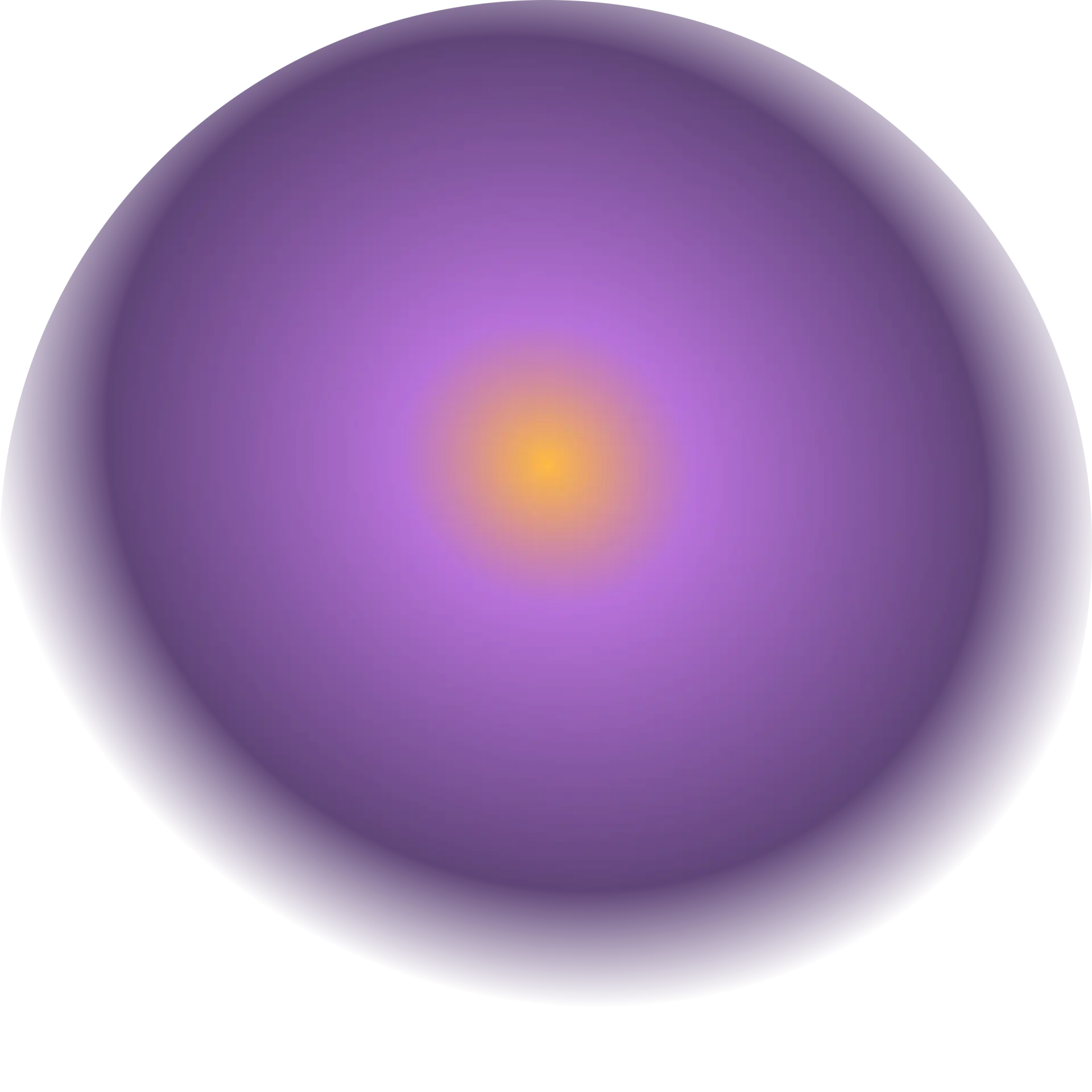
User Interface/Experience Researcher resume sample
- •Led a multi-phase user research initiative that improved product usability by 25%, significantly enhancing user satisfaction survey scores.
- •Collaborated with cross-functional teams to develop user personas, resulting in a more targeted product design strategy aligned with user needs.
- •Implemented a new user testing process using UserTesting, which accelerated feedback cycles and saved 30% of testing time.
- •Presented findings from observational studies to stakeholders, influencing product roadmap enhancements that increased user retention by 15%.
- •Conducted usability testing that identified critical user pain points, leading to feature improvements and a 20% boost in conversion rates.
- •Mentored junior researchers in advanced UX methodologies, fostering team growth and improving the overall quality of research deliverables.
- •Designed and conducted comprehensive user surveys, analyzing data to uncover insights that reduced user drop-off rates by 18%.
- •Identified user behavior patterns through quantitative analysis, informing design decisions that increased product engagement by 22%.
- •Collaborated closely with designers and product managers, ensuring user-centered design principles were integrated into all project phases.
- •Developed interactive journey maps that highlighted user experience pain points, leading to actionable design changes.
- •Initiated a series of workshops to align teams on user insights and UX best practices, enhancing collaboration and project outcomes.
- •Conducted user interviews and A/B testing that revealed critical insights, leading to a 40% improvement in user interface efficiency.
- •Analyzed usability testing data and provided the design team with actionable recommendations that improved user task completion rates by 28%.
- •Built and maintained a research repository, enabling easier access to historical data and fostering informed decision-making across teams.
- •Participated in the development of foundational UX methodologies that streamlined research processes and improved strategic planning.
- •Assisted in the creation of experience prototypes that facilitated better understanding of user interactions, resulting in improved user interface designs.
- •Collaborated with engineers and designers to integrate user feedback into development cycles, enhancing final product usability by 12%.
- •Supported the execution of comprehensive market research that provided insights into competitive positioning and user expectations in tech products.
- •Contributed to refining UX research methods, which streamlined processes and increased research efficacy by 20%.
Behavioral Insight Analyst resume sample
- •Led a comprehensive study into consumer preferences, enhancing product satisfaction by 20% through data-driven strategies.
- •Developed predictive analytics models, increasing the accuracy of behavioral trend forecasts by 35%.
- •Collaborated with cross-functional teams to streamline consumer insights reports, reducing analysis time by 40%.
- •Designed and maintained dashboards to visualize consumer behavior metrics, improving data accessibility for stakeholders.
- •Presented research findings to senior management, facilitating strategic decision-making and leading to a 10% increase in sales.
- •Optimized social media analytics to identify trends, contributing to a 25% boost in user engagement.
- •Conducted in-depth analysis of qualitative data from focus groups, generating insights that increased campaign effectiveness by 15%.
- •Streamlined data collection processes across departments, resulting in a 30% improvement in data integrity.
- •Integrated survey analysis into product development, leading to a 20% enhancement in customer satisfaction.
- •Utilized SQL and Python to automate data extraction, reducing reporting time by 25%.
- •Collaborated in the development of consumer behavior models, boosting prediction accuracy and enhancing decision-making.
- •Analyzed survey data to identify market trends, contributing to a 10% increase in market share.
- •Produced tailored reports for clients, enhancing engagement and satisfaction scores by 15%.
- •Created visual insights using Tableau to support strategic initiatives, simplifying complex data significantly.
- •Assisted in developing customer segmentation strategies, increasing targeted marketing efficiency by 20%.
- •Coordinated research efforts that improved client recommendations, leading to a 15% boost in client retention.
- •Presented data analysis outcomes to clients, helping to align strategic objectives and achieve a 12% revenue increase.
- •Developed surveys and research tools that enhanced data precision and analysis outcomes by 20%.
- •Played a key role in implementing data visualization techniques that accelerated insights delivery to clients.
Interactive User Experience Researcher resume sample
- •Led comprehensive user research initiatives that resulted in a 25% improvement in product usability.
- •Collaborated with multidisciplinary teams to define research objectives and inspire innovative design strategies.
- •Synthesized complex user data into actionable insights, increasing development efficiency by 30%.
- •Developed compelling presentations of UX research findings, enhancing stakeholder engagement by 40%.
- •Conducted usability testing using advanced software tools, leading to a 20% reduction in user navigation errors.
- •Pioneered new user personas and journey maps, aligning teams on customer-centric approaches.
- •Planned and conducted user research for a major software redesign, improving user satisfaction ratings by 18%.
- •Utilized qualitative methods to gather insights, impacting a product roadmap for a significant global client.
- •Collaborated with designers to implement findings, reducing feature misalignment issues by 35%.
- •Interpreted a large volume of user data, resulting in critical updates to interface design.
- •Advocated for user needs in regular meetings, directly enhancing the UX design process.
- •Facilitated field studies leading to a pivotal shift in the company’s mobile application strategy.
- •Contributed to significant adjustments in product features, boosting conversion rates by 22%.
- •Developed comprehensive reports communicating research findings to cross-functional teams.
- •Involved in creating detailed journey maps offering deep insights into customer behavior.
- •Supported senior researchers in executing extensive surveys, increasing participation rates by 15%.
- •Assisted in the analysis of qualitative data, leading to key recommendations for product improvements.
- •Engaged in collaborative workshops that fostered innovative approaches to UX challenges.
- •Contributed to the development of user personas, streamlining product development efforts.
Quantitative User Researcher resume sample
- •Developed and executed surveys leading to a 25% increase in survey response rate, improving the reliability of data collected.
- •Conducted behavioral analysis that informed 4 new feature additions, enhancing user satisfaction by 15%.
- •Collaborated with product teams resulting in a 30% increase in user engagement through targeted feature updates.
- •Utilized regression analysis to identify potential product improvements, boosting customer lifetime value by 20%.
- •Designed user segmentation strategies that refined marketing efforts and increased conversion rates by 10%.
- •Executed A/B testing which directly increased product feature adoption by 40% within one quarter.
- •Spearheaded data-driven research studies that improved user interface design, decreasing bounce rates by 15%.
- •Presented research findings using Tableau to stakeholders, resulting in actionable insights for strategic planning.
- •Formulated user behavior models that supported decision-making in product management, leading to a 25% revenue increase.
- •Aligned cross-functional teams in research needs, enabling a 20% faster project completion rate.
- •Managed quantitative research initiatives enhancing user experience and achieving a 50% reduction in customer churn.
- •Identified key user behavior trends, providing strategic insights that improved product offerings and raised user retention by 30%.
- •Utilized SPSS for analyzing complex datasets, delivering precision insights aligning with business objectives.
- •Designed and implemented research dashboards that streamlined data access for product teams, saving over 100 hours annually.
- •Analyzed large datasets to guide marketing strategies, resulting in a 15% increase in campaign effectiveness.
- •Collaborated in cross-departmental projects to integrate user data insights, optimizing product design features.
- •Conducted factor analysis improving data segmentation, leading to targeted user communication plans.
- •Presented analysis results to corporate stakeholders, shaping decisions that increased overall user satisfaction scores by 20%.
User Experience Testing Specialist resume sample
- •Led a team to conduct comprehensive user testing on five major software products, achieving a 30% improvement in user interface ratings.
- •Developed and executed over 20 user testing plans that yielded actionable insights for development, enhancing product uptake by 25%.
- •Facilitated usability tests with over 100 diverse user groups globally, ensuring feedback inclusion for culturally responsive design.
- •Produced detailed user experience reports that influenced strategic design changes, contributing to a 15% increase in customer satisfaction.
- •Collaborated with cross-functional teams to iterate product features, resulting in a streamlined user journey and 20% reduction in task completion time.
- •Introduced new testing software and methodologies, enhancing efficiency by 40% and keeping the company on the cutting edge of UX research.
- •Led user research initiatives across multiple product lines, collecting and analyzing data to inform UX decisions and enhance user satisfaction.
- •Recruited and managed usability test participants, ensuring a representative sample that improved testing relevance and accuracy.
- •Developed comprehensive reports on user experience testing, presenting findings that guided team strategies and improved user metrics by 15%.
- •Worked closely with designers and developers to integrate user feedback, which resulted in an improved UI/UX for three major software updates.
- •Monitored industry trends to innovate testing techniques, enabling the adaptation of cutting-edge practices that improved testing accuracy by 20%.
- •Conducted cross-platform usability tests that contributed to enhanced software versatility and user engagement growth by 40%.
- •Worked on wireframing and prototyping, significantly reducing design iteration time and improving design output quality.
- •Presented user research findings during stakeholder meetings, resulting in design approvals 25% faster than normal due to data-driven insights.
- •Implemented accessibility standards that broadened the user base, increasing product accessibility to disabled users by 15%.
- •Initiated user feedback sessions and surveys, helping to identify key areas for product enhancement that boosted user experience ratings by 10%.
- •Collaborated with designers to optimize user interfaces, leading to a more intuitive product navigation and decreased user transaction times.
- •Utilized A/B testing methodologies, resulting in data-enabled insights that informed pivotal design adaptations and increased conversion rates by 5%.
- •Assisted in employing wireframing tools that improved product mockups, accelerating project timelines by 20%.
Digital Customer Experience Researcher resume sample
- •Led a team of researchers to conduct 50+ usability tests, which led to a 40% increase in product engagement.
- •Collaborated with product managers to integrate customer feedback into new features, enhancing user satisfaction ratings by 30%.
- •Designed and implemented a complex survey system that identified critical user pain points, reducing the churn rate by 15%.
- •Presented research findings to cross-functional teams, which influenced over 70% of product enhancements.
- •Developed detailed customer journey maps, increasing cross-departmental understanding of user behaviors and needs.
- •Analyzed survey data to uncover new user persona trends, resulting in a 25% boost in targeted marketing effectiveness.
- •Utilized data analysis tools to understand customer trends, boosting sales conversion rate by 20% through targeted strategies.
- •Conducted in-depth interviews that revealed key friction points, informing product teams and optimizing user pathways.
- •Developed comprehensive reports on user feedback, helping the design team reduce feature complaints by 40%.
- •Implemented a mixed-methods research approach to refine a UX design, shortening developmental timelines by 15%.
- •Engaged in cross-departmental workshops to ensure alignment on customer experience improvements across projects.
- •Pioneered a user testing framework that doubled the efficiency of product iteration cycles.
- •Applied quantitative and qualitative analysis to user feedback, generating insights that improved UX scores by 30%.
- •Collaborated with designers to model user personas, achieving a 20% increase in website usability.
- •Contributed to case studies showcasing successful customer experience enhancements, driving 10% more client proposals.
- •Conducted market research and analysis that informed digital campaign strategies, increasing click-through rates by 25%.
- •Analyzed customer data to identify trends, guiding strategic decisions that reduced acquisition costs by 18%.
- •Developed actionable reports for marketing teams, leading to a 40% improvement in ad targeting accuracy.
- •Championed cross-platform user experience analyses, achieving a 15% rise in user retention.
Human-Computer Interaction Researcher resume sample
- •Led a team to develop user-centered design solutions, which increased user engagement by 25% in product testing.
- •Conducted comprehensive usability tests affecting 3 new product lines, enhancing user experience metrics by 20%.
- •Evaluated user feedback and analytics for prototypes, reducing errors by 30% in user interface design resulting in higher satisfaction.
- •Collaborated with cross-functional teams, integrating research insights that decreased feature development timelines by 15%.
- •Created detailed presentations to communicate research outcomes, influencing strategic decisions and securing a 40% budget increase for HCI initiatives.
- •Developed wireframes and prototypes showcasing design improvements, which were adopted in over 50% of ongoing projects.
- •Executed eye-tracking studies that provided critical insights, leading to a 15% increase in web navigation efficiency.
- •Designed surveys and conducted interviews that improved understanding of user needs, doubling user satisfaction scores for targeted services.
- •Collaborated with product teams, driving implementation of research data that reduced customer support requests by 20%.
- •Synthesized complex datasets into actionable insights, improving decision-making processes contributing to a 30% reduction in time-to-market.
- •Advocated for inclusive design standards, ensuring accessibility in released products aligning with compliance laws.
- •Implemented user research methodologies improving the product usability index by 30% over four product iterations.
- •Facilitated workshops with design teams, integrating user feedback that resulted in a 25% increase in prototype acceptance rates.
- •Developed extensive user journey maps, which clarified user pathways and enhanced product narrative orientation by 40%.
- •Reported precise findings from ethnographic studies, achieving significant UX redesigns impacting over 100,000 active users.
- •Produced high-fidelity prototypes using Adobe Creative Suite, leading to a 35% increase in design approval rates across departments.
- •Redefined user interface guidelines, leading to a consistent 20% enhancement in user feedback scores for new applications.
User Centric Product Researcher resume sample
- •Conducted 50+ user interviews and usability tests, improving product design, and resulting in a 30% increase in user retention rate.
- •Developed detailed user personas and journey maps that informed design decisions, enhancing the overall user experience and satisfaction.
- •Led cross-functional workshops to implement research insights directly into product lifecycle, speeding up development by 20%.
- •Streamlined research processes by introducing innovative data collection methods, leading to a 15% improvement in data accuracy and insights.
- •Spearheaded a research initiative focused on accessibility features, contributing to a 40% rise in engagement among users with disabilities.
- •Presented user research findings to stakeholders, simplifying complex data into clear, actionable insights, influencing strategic roadmaps.
- •Redesigned user feedback processes to collect quantitative data more efficiently, increasing response rate by 35%.
- •Collaborated closely with product managers to integrate user feedback into the development cycle, improving product-market fit.
- •Designed and implemented extensive user testing plans, gathering actionable insights that led to a 20% decrease in product bugs.
- •Communicated complex research findings in presentations, influencing product strategy decisions and enhancing team alignment on goals.
- •Monitored industry trends and applied best practices, keeping the team informed and maintaining a competitive edge.
- •Implemented survey methodologies that provided actionable insights, increasing customer satisfaction by 15%.
- •Collaborated with designers to prototype user-centric features, enhancing product functionality and user engagement.
- •Analyzed large datasets to reveal user behavior patterns, directly impacting feature development and prioritization.
- •Facilitated user research training for junior team members, improving research quality and team efficiency across projects.
- •Conducted ethnographic studies providing deep insights into user lifestyles, driving a 25% increase in targeted marketing success.
- •Developed comprehensive usability test scripts, aiding in the identification of key pain points and enhancing user experiences.
- •Managed a project to revamp onboarding user journeys, resulting in a 40% reduction in dropout rates during sign-up processes.
- •Led a cross-functional team to adapt user feedback into product iterations, achieving high stakeholder satisfaction and seamless product releases.
Mobile User Experience Researcher resume sample
- •Led comprehensive user research projects that increased user satisfaction by 25%, resulting in enhanced product value propositions.
- •Developed and implemented new user journey mapping processes, decreasing pain points by 40% across mobile platforms.
- •Conducted robust A/B testing resulting in a 15% improvement in feature adoption rates for flagship mobile applications.
- •Collaborated closely with cross-functional teams, yielding insights that informed product design strategies and enhanced user experiences.
- •Advocated user needs throughout the design phase, contributing to a 30% increase in overall user retention.
- •Presented detailed findings to stakeholders, shifting key product decisions and driving mobile app innovations.
- •Executed user interviews and surveys that revealed critical user insights, influencing mobile application upgrades and redesign.
- •Utilized analytics software to interpret user behavior data, resulting in a 20% usability improvement of mobile apps.
- •Led usability testing sessions which informed the re-launch strategy of a major mobile feature, enhancing user experience.
- •Collaborated with developers and designers to ensure user-centric designs, aligning mobile development with user feedback.
- •Presented analysis of user behavior trends to product managers, guiding the development of market-leading mobile features.
- •Conducted cross-platform usability tests that contributed to a 10% increase in app efficiency and user satisfaction.
- •Prepared and delivered reports with actionable recommendations, prompting pivotal changes in mobile UX design strategy.
- •Assessed mobile user behavior through detailed research methods, impacting app interface design and functionality revamp.
- •Engaged with stakeholders to integrate user feedback into the design process, ensuring a user-focused development approach.
- •Assisted in conducting qualitative research studies, providing insights that informed mobile product roadmaps.
- •Supported user journey and persona development for mobile platforms, impacting the strategic planning of feature sets.
- •Contributed to high-profile mobile app projects by supplying data-driven insights from user behavior analysis.
- •Facilitated user workshops that gathered feedback critical to the success of new mobile app features.
Cognitive User Experience Researcher resume sample
- •Led user research initiatives that informed design improvements, enhancing product usability by 25% over twelve months.
- •Collaborated cross-functionally, integrating research insights into development, which increased feature adoption by 40%.
- •Developed and executed comprehensive research plans employing methods like A/B testing and interviews, resulting in actionable insights that reduced bounce rate by 15%.
- •Presented data-driven findings to executives, improving stakeholder engagement and aligning teams towards user-centric strategies.
- •Conducted surveys and usability studies, streamlining user interfaces and boosting user engagement by 20% year-on-year.
- •Introduced innovative research methodologies, significantly enhancing team's efficiency and reducing project turnaround times by 10%.
- •Executed multi-modal user research that informed new product strategies, directly contributing to a 50% increase in customer acquisition.
- •Reduced project costs by 12% through rigorous data analysis and strategic recommendations for design process improvements.
- •Communicated complex cognitive insights through succinct reports, influencing decision-making across design and product teams.
- •Steered ethnographic research projects that uncovered user pain points, resulting in 18% improvement in user satisfaction metrics.
- •Pioneered new testing protocols that expedited research findings, expediting product releases and saving 4 weeks of development time.
- •Applied cognitive psychology principles to design thinking processes, advancing user-centered design by 35% efficiency.
- •Analyzed behavioral data to drive interface design changes, enhancing accessibility for over 2 million users globally.
- •Partnered with design teams to ideate solutions based on statistical data, improving product usability scores by 15%.
- •Conducted over 50 user interviews and focus groups, feeding key insights into development cycles to optimize functionality.
- •Supported UX research projects, contributing to improvements in customer engagement levels that rose by 27% in six months.
- •Prepared and analyzed survey data, unveiling hidden trends that guided 10 new feature developments in software products.
- •Collaborated with cross-functional teams implementing user research findings, elevating customer satisfaction scores by 8%.
- •Crafted detailed presentations to communicate research impacts, fostering a data-driven culture within product teams.
Creating an effective user experience researcher resume is like designing a seamless user interface; it demands clarity, precision, and a splash of creativity. In the competitive job market, every application is your chance to shine. A well-crafted resume can help you clearly communicate your unique skills and experiences.
Balancing technical expertise and storytelling in your resume is essential. Your career journey should speak directly to recruiters, making complex ideas easy to grasp. Starting with a professional resume template ensures that your information is presented elegantly and effectively.
Your skills as a user experience researcher are vital. Demonstrate how your work has enhanced usability and led to impactful project outcomes, connecting these achievements with metrics or results to strengthen your narrative.
A clear, structured resume format keeps your accomplishments organized and easy to navigate, much like a well-designed website. Consider exploring these helpful resume templates to find a layout that best fits your story.
Your resume is more than a document; it’s the foundation of your career story and often the first impression you make on potential employers. Ensure every word adds value, transforming your resume into a powerful tool that opens doors and captures opportunities in your field.
Key Takeaways
- Creating an effective user experience researcher resume is akin to designing a user interface, requiring clarity, precision, and creativity, with an emphasis on clearly communicating skills and experiences.
- Balancing technical expertise with storytelling, using professional templates, and presenting achievements through metrics enhances the effectiveness of the resume.
- A clear, structured format, appropriate font choices, and PDF format for consistency can significantly impact the resume's presentation and readability.
- Using a reverse-chronological order for the experience section, with quantifiable achievements and action verbs, showcases your impact effectively.
- Including sections like contact information, professional summary, skills, experience, education, certifications, and possible extra sections like languages or volunteer work offers a well-rounded view of your qualifications.
What to focus on when writing your user experience researcher resume
A user experience researcher resume should effectively convey your expertise in understanding user needs and leveraging those insights for product enhancement. This begins with highlighting your proficiency in research methods and tools, and extends to emphasizing your ability to communicate and collaborate seamlessly with diverse teams.
How to structure your user experience researcher resume
- Contact Information — Your contact information should be clear and concise, including your full name, phone number, email address, and LinkedIn profile. This section, though simple, is crucial as it provides the means for potential employers to reach you effortlessly and should be formatted for easy readability.
- Professional Summary — This is your opportunity to capture attention with a brief yet impactful statement about your background as a User Experience Researcher. Here, outline the years of experience you possess, and key skills such as user-centered design and usability testing that define your professional journey. Aim to set the stage for the detailed information that follows.
- Skills — List your skills in a way that clearly articulates your strengths in the field. Essential skills might include creating user personas, journey mapping, empathy mapping, and proficiency in research tools like Qualtrics or Morae. Tailor these skills to meet industry demands and align with the job description for which you’re applying.
- Experience — This section should focus on your work history, particularly emphasizing roles directly related to UX research. Detail your responsibilities through bullet points, highlighting achievements like improvements in user satisfaction rates or enhancements in product usability. Use quantifiable outcomes to underscore the impact of your contributions.
- Education — Highlight your educational background by stating your degree, the name of the institution, and your graduation year. Bring attention to relevant coursework or projects that align with UX research concepts, such as those centered around human-computer interaction or psychology, to showcase your academic foundation.
- Certifications — Showcasing UX-specific certifications like a Certified Professional for Usability and User Experience (CPUX) can further establish your credibility and dedication to your profession. Certifications highlight your commitment to ongoing learning and excellence in user experience research.
As each section of your resume plays a pivotal role, the sections above will be further explored below to provide more in-depth guidance on how best to structure each element of your resume to make a strong impression.
Which resume format to choose
Crafting an effective resume as a user experience researcher begins with selecting the right format, as clarity and organization are key in this field. Opting for a reverse-chronological format allows you to highlight your most recent and relevant experiences upfront, making it straightforward for employers to track your career progression and grasp your achievements in a logical sequence. This approach not only showcases your expertise but also aligns with expectations within the industry, where a clear narrative is often valued.
Choosing the right fonts plays a subtle yet important role in enhancing your resume's overall impact. Modern options like Rubik, Lato, or Montserrat provide a clean and contemporary look, making your information easy to digest. These fonts reflect your awareness of design trends, which is crucial in a field that values visual user experience. Avoid default choices like Arial or Times New Roman, as they may not convey the innovative spirit you're aiming to showcase.
Ensuring your resume maintains its intended design and readability across platforms means opting for a PDF format. Saving your work as a PDF protects your careful formatting choices, ensuring that the employer sees exactly what you intended, without unexpected shifts in layout or style. This consistency is vital in presenting a polished and professional image.
Lastly, consider the margins you use, as they contribute significantly to your resume's presentation and readability. Margins between 0.5 to 1 inch create a balanced, uncluttered appearance, providing enough white space to allow the content to breathe while making the most of the available space for your details.
Every element of your resume—from the layout and fonts to the format and margins—works together to present your skills and experience as a user experience researcher in the best light. These choices not only demonstrate your attention to detail but also reflect the principles of good design that are central to your profession.
How to write a quantifiable resume experience section
A strong user experience researcher resume experience section emphasizes your achievements and improvements in user interfaces. Begin with a reverse-chronological order to highlight your most recent work, making it easy for hiring managers to see your latest accomplishments. Focus on including roles from the last decade, unless earlier positions are crucial to your career. Job titles should clearly reflect your responsibilities and contributions. Tailor your resume to the job ad by ensuring each experience entry aligns with the employer's needs. Use action words such as "achieved," "conducted," and "improved" to highlight your impact effectively. Make sure your bullet points contain quantifiable achievements to make them memorable and impressive.
- •Boosted user satisfaction scores by 25% by identifying and resolving major UX issues.
- •Conducted over 50 usability tests, leading to a 30% improvement in feature intuitiveness.
- •Worked with cross-functional teams to launch three major product updates early.
- •Cut user support tickets by 40% by redesigning the FAQ section based on user feedback.
This experience section effectively showcases your ability to make a significant impact, connecting each point smoothly to tell a cohesive story about your role. By highlighting a 25% rise in user satisfaction and a 40% decrease in support tickets, it provides tangible evidence of your success. The use of strong action verbs, like "boosted" and "conducted," clearly reflects your active contributions to enhancing user experiences. Each achievement links naturally to the next, illustrating your focus on collaboration and results. This tailored approach ensures that your resume speaks directly to potential employers, showing that you understand their needs and have the expertise to meet them.
Project-Focused resume experience section
A project-focused user experience researcher resume experience section should effectively connect your involvement in projects to the successful outcomes they achieved. Start with a brief overview of each project, concentrating on its aims and your critical role. Highlight how your research efforts directly contributed to reaching these goals, creating a cohesive story of impact.
In the bullet points, detail the specific tasks you undertook, the research methods you applied, and the measurable results you generated. This structure helps illustrate your effectiveness in enhancing project outcomes. Emphasize your collaborative skills, innovative approach, and ability to refine designs. Each point should naturally lead to the next, painting a clear picture of your contributions.
User Experience Researcher
Tech Innovations
2020-2022
- Led a team through user interviews and usability testing, resulting in a 30% boost in customer satisfaction. This foundation allowed us to tailor the product more effectively.
- Created user personas from research data, which guided design choices. These personas increased user engagement by 25% as they were perfectly aligned with user needs.
- Collaborated with cross-functional teams to refine product designs, cutting down time to market by 20%, showcasing the power of interdisciplinary teamwork.
- Set up A/B testing to uncover user preferences, leading to a 15% rise in sales. These insights ensured our design decisions were data-driven and customer-focused.
Leadership-Focused resume experience section
A leadership-focused user experience researcher resume experience section should begin by showcasing your capability to guide and motivate teams towards creating effective design solutions. Illustrate scenarios where your leadership was key to achieving project success. Explain the approaches and strategies you implemented to reach significant goals, emphasizing the real impact your leadership had. Each bullet point should naturally reflect a leadership skill, such as team coordination, strategic planning, or fostering collaboration across different functions.
Use straightforward language to describe your achievements and detail the steps you took to guide initiatives. Focus on contributions that significantly benefited your team and the organization, turning goals into measurable outcomes. By including metrics, you provide evidence of your success and highlight the tangible benefits your leadership brings. This approach helps employers clearly see your value as a leader in user experience research.
Senior UX Researcher
Tech Innovations Inc.
June 2019 - Present
- Led a team of 5 researchers in a global user study, boosting product usability by 40%.
- Created a mentorship program that enhanced team skills and fostered collaboration.
- Organized cross-functional workshops that improved project efficiency by 30%.
- Introduced a new research method, cutting the project timeline by 25%.
Responsibility-Focused resume experience section
A responsibility-focused user experience researcher resume experience section should illustrate how your actions have led to meaningful project results. Start by showcasing specific achievements using concrete numbers, such as the volume of user interviews conducted or improvements in user satisfaction. This use of active language helps emphasize your direct impact and allows the reader to grasp the significance of your contributions in delivering measurable outcomes. By doing this, you provide potential employers with confidence in your ability to drive UX success.
Employ bullet points to clearly and effectively outline your main responsibilities and achievements. Begin each bullet with an action verb, focusing on successes that demonstrate your skill in converting user insights into actionable research findings. When you detail your involvement in product development, specify which stages you were engaged in and any collaborations with design or development teams. By clearly underscoring these elements, your resume stands out, showcasing your proficiency, effectiveness, and reliability in delivering research-driven, insightful results.
User Experience Researcher
Tech Innovations Co.
June 2021 - Present
- Conducted over 50 user interviews, identifying key pain points and reducing onboarding time by 20%.
- Collaborated with design teams to create wireframes based on user feedback, enhancing navigation by 30%.
- Led usability testing sessions with prototype iterations, increasing user satisfaction rates by 25%.
- Designed surveys capturing user needs, influencing product roadmap changes and feature additions.
Growth-Focused resume experience section
A growth-focused user experience researcher resume experience section should clearly demonstrate how you've contributed to significant changes and advancements in your previous roles. Start with your role and the company, including your employment dates, to set the context. Use bullet points to succinctly showcase your contributions, highlighting achievements with measurable results to demonstrate your impact. By detailing the methodologies and tools you employed, you can illustrate how your insights led to improved product development, enhanced user satisfaction, and supported company growth.
Connect each bullet point to show a cohesive narrative of how your work has benefited your team or organization. Use action verbs to convey your involvement in projects and initiatives, and be specific about your contributions. Emphasize your collaboration with cross-functional teams, such as product managers, designers, and engineers, to underline how your research insights were implemented effectively. Finally, underscore your role in achieving improvements in user metrics or successful product launches, showcasing your ability to drive lasting positive change in the company.
User Experience Researcher
Tech Innovations Co.
Jan 2020 - Jul 2023
- Conducted over 50 user interviews and usability tests that improved the product's user satisfaction score by 20%.
- Collaborated with design and development teams to integrate feedback, reducing user dropout rates by 15%.
- Led a team of researchers in a major project that informed significant product pivots, leading to a 25% increase in daily active users.
- Developed a research repository for a mid-sized tech company, enhancing efficiency across the product lifecycle.
Write your user experience researcher resume summary section
A user-focused resume summary for a user experience researcher should effectively highlight your skills and achievements in a compelling, cohesive manner. This section is your chance to make a strong first impression by showcasing your expertise and the impact you’ve had on previous projects. When you have significant experience, a resume summary is an excellent way to emphasize your strengths. Here’s an example to consider:
This summary flows naturally by linking your skillset with the tangible results you've accomplished. Highlighting a specific achievement, like the increase in user satisfaction, provides evidence of your impact. The focus on user-centered design creates a cohesive narrative of your strengths. If you are earlier in your career, you might opt for a resume objective, which outlines your goals for the future. A resume profile is broader, while a summary of qualifications presents your skills and accomplishments in bullet points. By clearly conveying your experience and achievements, a well-connected summary enhances your resume and captures the attention of potential employers.
Listing your user experience researcher skills on your resume
A skill-focused user experience researcher resume should strategically highlight your abilities to stand out. You have the option to create a dedicated skills section or seamlessly integrate skills into other parts like your experience or summary. Both methods effectively showcase what you bring to the table. Your strengths often stem from soft skills like communication and teamwork, emphasizing how well you interact with others. Meanwhile, hard skills relate to specific technical abilities such as expertise in usability testing or wireframing tools, showing your proficiency with concrete tasks.
By strategically using your skills and strengths as keywords, you enhance your resume's visibility in the software used by recruiters. This increases your chances of being noticed during the initial screening process.
Consider this example of a focused skills section:
This example pinpoints critical skills necessary for a user experience researcher. It’s concise yet comprehensive, using each skill as a valuable keyword to capture attention during resume screenings.
Best hard skills to feature on your user experience researcher resume
These hard skills demonstrate your technical prowess and precision, showcasing not only what you know but also how adeptly you apply your expertise:
Hard Skills
- User Research
- Usability Testing
- Data Analysis
- Prototyping
- Wireframing
- A/B Testing
- Journey Mapping
- Card Sorting
- Persona Development
- Survey Design
- Statistical Analysis
- Heatmaps Analysis
- Heuristic Evaluation
- Cognitive Walkthroughs
- UX Design
Best soft skills to feature on your user experience researcher resume
Highlighting soft skills reveals your ability to collaborate and solve problems efficiently. These skills underscore the interpersonal qualities that make you a valuable member of any team:
Soft Skills
- Empathy
- Communication
- Problem Solving
- Adaptability
- Team Collaboration
- Critical Thinking
- Creativity
- Time Management
- Attention to Detail
- Listening
- Emotional Intelligence
- Openness to Feedback
- Storytelling
- Conflict Resolution
- Leadership
How to include your education on your resume
The education section is a crucial part of your user experience researcher resume. It showcases your academic background and establishes your qualifications. Tailor this section to the position by including only relevant education. If certain academic pursuits do not align with the job, it’s best to leave them out. When listing your degree, start with the most recent one. If your GPA is strong (typically above 3.0), consider including it along with the phrase "cum laude" if applicable. This distinction highlights honors and achievements during your academic journey.
- •Graduated cum laude
- •Completed a thesis on user-centered design
The outstanding user experience researcher resume education section example includes a degree directly related to user experience research, making it relevant for the target job. The "Master of Human-Computer Interaction" is a specialized degree showing expertise. Including a high GPA and "cum laude" honors enhances credibility. Bullets about the thesis work provide additional context about specific research skills. This detailed and focused presentation helps potential employers see the value you can bring to their team as a user experience researcher.
How to include user experience researcher certificates on your resume
Including a certificates section in your user experience researcher resume is crucial as it showcases your professional qualifications and dedication to continuous learning. List the name of each certificate clearly so potential employers can identify your specific skills and knowledge areas. Include the date you received the certificate to provide context about your recency in skills. Add the issuing organization to lend credibility and show the respected sources from which you attained your knowledge.
Certificates can sometimes be included in the header for a concise summary. For instance, your header might look like this: "Certified UX Researcher | User Experience Design, Interaction Design Foundation." This approach allows hiring managers to immediately recognize your qualifications.
Here's a good example of a standalone certificates section:
This example is strong because it lists certificates directly related to user experience research, underscoring your expertise in relevant skills. The inclusion of renowned institutions like the University of Michigan and Stanford University adds to your credibility as a candidate. This succinctly emphasizes your efforts to stay current in your field, making your resume more compelling to employers.
Extra sections to include on your user experience researcher resume
Creating a standout resume as a user experience researcher involves more than just listing your work history. Including diverse sections can give employers a fuller picture of who you are and what you bring to a team. Each section of your resume should serve the purpose of showcasing your unique skills and attributes.
Language section — Highlight language skills to show your ability to communicate with diverse users, which is vital in understanding varied user needs and experiences. This section can also demonstrate your adaptability and willingness to engage with different cultures.
Hobbies and interests section — Share hobbies and interests to give employers a sense of your personality and creativity, which are valuable in the research process. Engaging in creative pursuits can show you approach problem-solving in innovative ways.
Volunteer work section — List volunteer activities to showcase your commitment to community and teamwork, important aspects of a successful user experience researcher. Volunteering also highlights your initiative and ability to work collaboratively.
Books section — Mention books you have read to demonstrate your continual learning and interest in staying informed about industry trends. This can also illustrate your intellectual curiosity and commitment to personal and professional growth.
Incorporating these sections can make your resume more engaging and reflective of your diverse skills as a user experience researcher. Keep each section brief yet impactful, providing just enough detail to intrigue potential employers. Ultimately, a well-rounded resume can set you apart by showing that you’re not just experienced, but also passionate and involved in your field.
In Conclusion
In conclusion, crafting a user experience researcher resume requires careful consideration and strategic presentation of your skills and experiences. By focusing on clarity and organization, you can create a resume that mirrors the principles of effective UX design. Highlighting your technical skills alongside storytelling elements can make your resume stand out to potential employers. Utilize a professional template to ensure your information is presented in an elegant and effective manner, and consider PDF formatting to maintain consistent layout across platforms. Each section of your resume, from skills to experience, should demonstrate your proficiency and commitment to user-focused design and research. Remember, your resume is not just a document; it is the gateway to an array of career opportunities in the competitive job market. By providing quantifiable achievements and specific contributions to past projects, you can clearly show your impact and value as a researcher. Including additional sections like certifications, volunteer work, or language skills can showcase your diverse capabilities and interests. Ultimately, a well-rounded resume will give employers a comprehensive view of your abilities, ensuring you leave a lasting first impression and ultimately helping you stand out in your field.
Related Articles
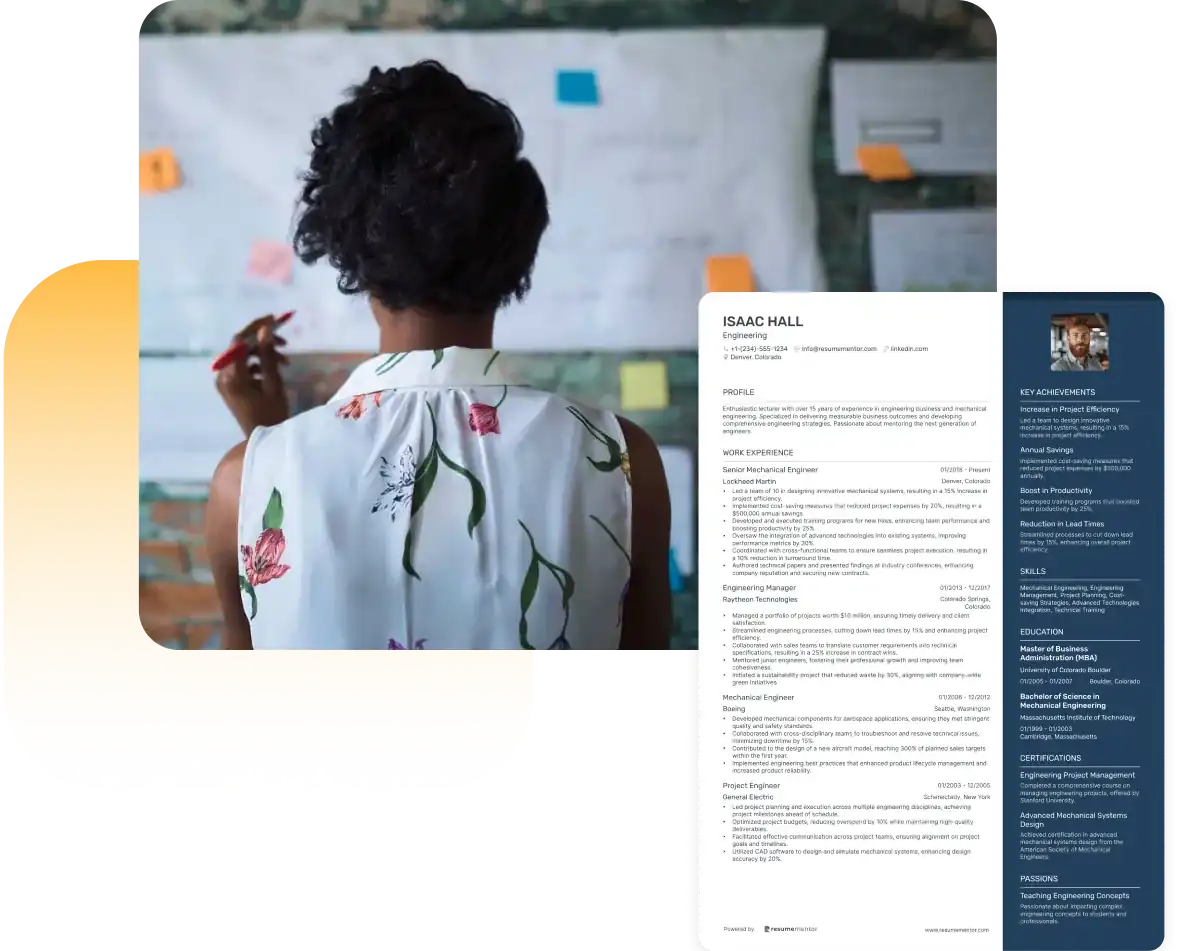
Continue Reading
Check more recommended readings to get the job of your dreams.
Resume
Resources
Tools
© 2025. All rights reserved.
Made with love by people who care.

